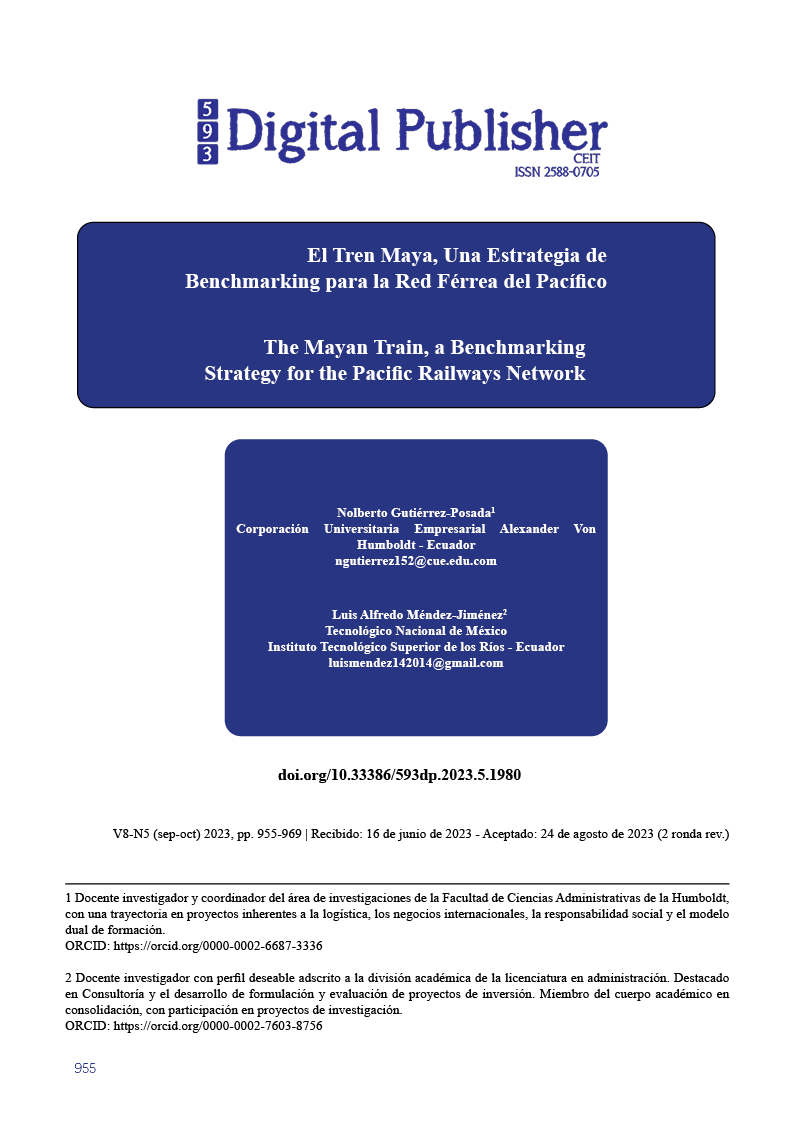The Mayan Train, a Benchmarking Strategy for the Pacific Railways Network
Main Article Content
Abstract
In order to boost the regional and local economy in a competitive manner, both the Colombian and Mexican governments are promoting initiatives to strengthen the transportation of goods, reactivate tourism and improve passenger mobility. These initiatives are based on strengthening railroad transportation, for which large-scale projects are being developed in Mexico in the Yucatan Peninsula, such as the so-called Mayan Train, and in Colombia the reactivation of railroads, with special interest in the Pacific Railroad Network, which links the country's most important port, Buenaventura, with the productive centers. By means of a comparative analysis between the two regions, using the methodology of field visits, we seek to establish the technical conditions, state promotion and territory of the Pacific railroad network and the Mayan Train as a development alternative to the bets for sustainable growth.
Downloads
Article Details

This work is licensed under a Creative Commons Attribution-NonCommercial-ShareAlike 4.0 International License.
1. Derechos de autor
Las obras que se publican en 593 Digital Publisher CEIT están sujetas a los siguientes términos:
1.1. 593 Digital Publisher CEIT, conserva los derechos patrimoniales (copyright) de las obras publicadas, favorece y permite la reutilización de las mismas bajo la licencia Licencia Creative Commons 4.0 de Reconocimiento-NoComercial-CompartirIgual 4.0, por lo cual se pueden copiar, usar, difundir, transmitir y exponer públicamente, siempre que:
1.1.a. Se cite la autoría y fuente original de su publicación (revista, editorial, URL).
1.1.b. No se usen para fines comerciales u onerosos.
1.1.c. Se mencione la existencia y especificaciones de esta licencia de uso.
References
Ancho de vía. (2022). En Wikipedia, la enciclopedia libre. https://es.wikipedia.org/w/index.php?title=Ancho_de_v%C3%ADa&oldid=145422663
AndrexWeb. (2014). Ferrocarriles Colombianos: Ferrocarril del Pacifico. Blog. https://ferrocarrilescolombianos.blogspot.com/p/ferrocarril-del-pacifico.html
Arias de Greiff, J. (2016). Ferrocarriles en Colombia. Biblioteca Luis Ángel Arango. https://www.banrepcultural.org/biblioteca-virtual/credencial-historia/numero-257/ferrocarriles-en-colombia-1836-1930
Correa, J. S. (2019). El tren de Panamá y la idea de una ruta transcontinental. Panorama Cultural. https://panoramacultural.com.co/historia/6738/el-tren-de-panama-y-la-idea-de-una-ruta-transcontinental
Correa R., J. S. (2013). Railroad contract models in Colombia: The cauca railroad in the 19th century | Modelos de contratación férrea en Colombia: El ferrocarril del cauca en el siglo XIX. Historia Critica, 51, 199-222. https://doi.org/10.7440/histcrit51.2013.09
Cuellar Jiménez, G. (2017). Ferrocarril del Pacífico. Estación de Armenia -. Web site oficial. https://babel.banrepcultural.org/digital/collection/p17054coll19/id/44/
DANE. (2019). Censo Nacional de Población y Vivienda: Información general. https://sitios.dane.gov.co/cnpv/#!/cua_som
Europa Press. (2015, abril 21). VÍDEO: Un tren japonés maglev bate record de velocidad, con 603 km/h. Europa Press. https://www.europapress.es/ciencia/laboratorio/noticia-video-tren-japones-maglev-bate-record-velocidad-603-km-20150421103300.html
Ferrocarriles del Norte de Colombia S.A. [FENOCO]. (2017). Historia del Ferrocarril. Web site oficial. https://www.fenoco.com.co/index.php/quienes-somos/historia-de-ferrocarril
Francia acelera hasta los 574 Km/h. (2007, abril 3). El País. https://elpais.com/tecnologia/2007/04/03/actualidad/1175588881_850215.html
INEGI. (1998a, enero 1). México en cifras Chiapas. Instituto Nacional de Estadística y Geografía. INEGI. https://www.inegi.org.mx/app/areasgeograficas/
INEGI. (1998b, enero 1). México en cifras—Campeche. Instituto Nacional de Estadística y Geografía. INEGI. https://www.inegi.org.mx/app/areasgeograficas/?ag=04#collapse-Resumen
INEGI. (1998c, enero 1). México en cifras—Quintana Roo. Instituto Nacional de Estadística y Geografía. INEGI. https://www.inegi.org.mx/app/areasgeograficas/
INEGI. (1998d, enero 1). México en cifras—Tabasco. Instituto Nacional de Estadística y Geografía. INEGI. https://www.inegi.org.mx/app/areasgeograficas/?ag=27#collapse-Resumen
INEGI. (1998e, enero 1). México en cifras—Yucatán. Instituto Nacional de Estadística y Geografía. INEGI. https://www.inegi.org.mx/app/areasgeograficas/
International Union of Railways. (2015). High Speed Rail: Fast track to sustainable mobility. Passenger and High-Speed Department. https://uic.org/IMG/pdf/high_speed_brochure.pdf
Poveda, G. (2002). El Primer Ferrocarril En Colombia. Dyna, 69(137), 61-73.
Russell, J. (2008). Trains: Past, present and future. 3. http://learnenglish.britishcouncil.org/en/magazine/trains-past-present-and-future
World Bank. (2017). Railway Reform. World Bank, Washington, DC. https://doi.org/10.1596/30734



